Development of a Person-Centred Care Plan for Harold's Case
VerifiedAdded on 2023/01/11
|11
|2327
|91
Report
AI Summary
This report presents a person-centred care plan for an 83-year-old male patient named Harold, who has a history of left cerebral vascular accident and angina. The plan addresses his complex medical history, including angina, and identifies the importance of considering past medical history for effective healthcare. The report focuses on nursing interventions for imbalanced nutrition, recognizing the patient's overweight status and related risks. It suggests interventions like weight loss monitoring, dietary advice, and monitoring of food and water intake. The plan also addresses the risk of fluid imbalance, emphasizing the need for monitoring input and output, and the importance of assessing the patient's condition, including symptoms like weakness and dry mouth. The conclusion summarizes the key findings and recommendations, highlighting the need for a balanced diet and monitoring for fluid imbalances to prevent further health complications. The report references relevant literature to support the care plan.
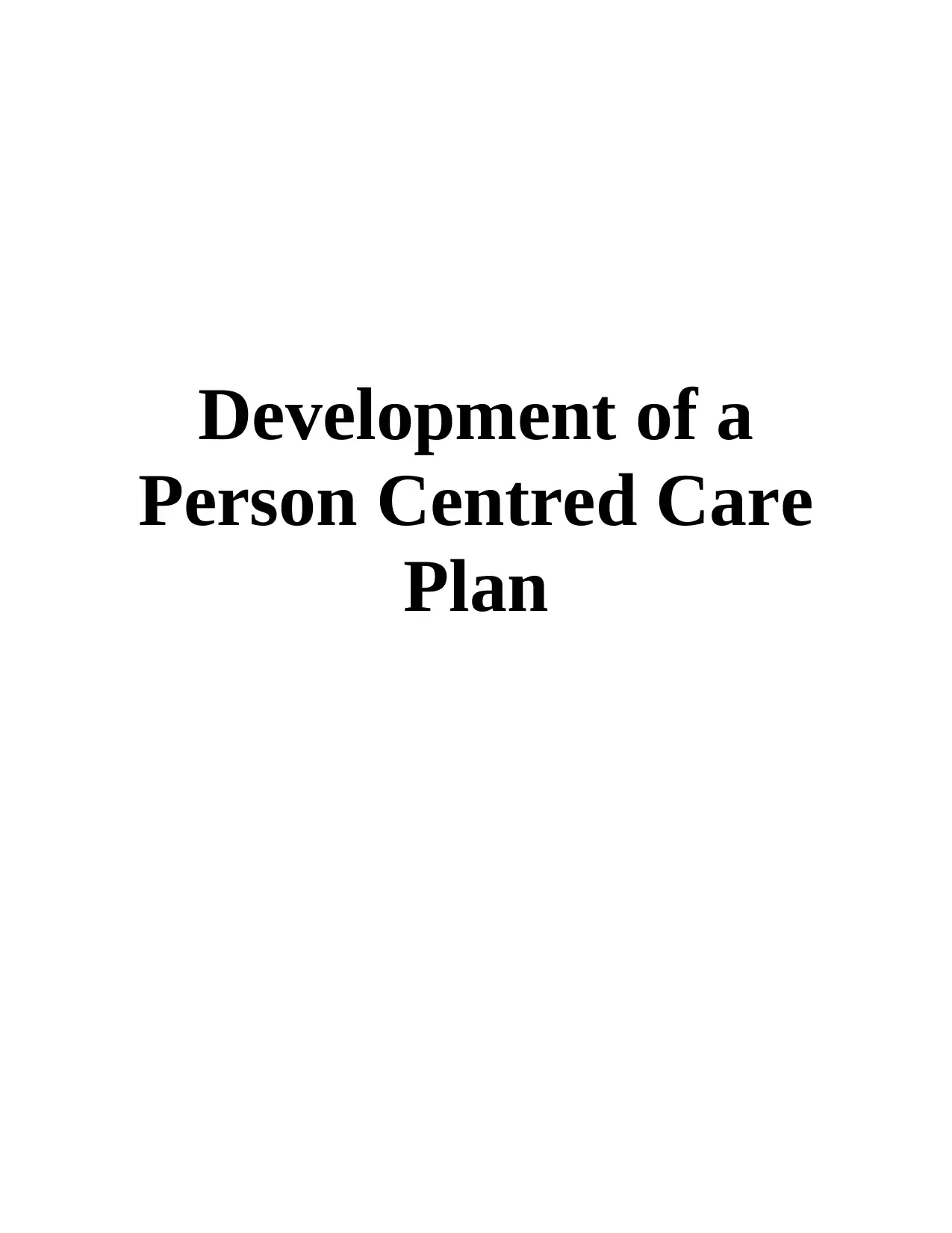
Development of a
Person Centred Care
Plan
Person Centred Care
Plan
Paraphrase This Document
Need a fresh take? Get an instant paraphrase of this document with our AI Paraphraser
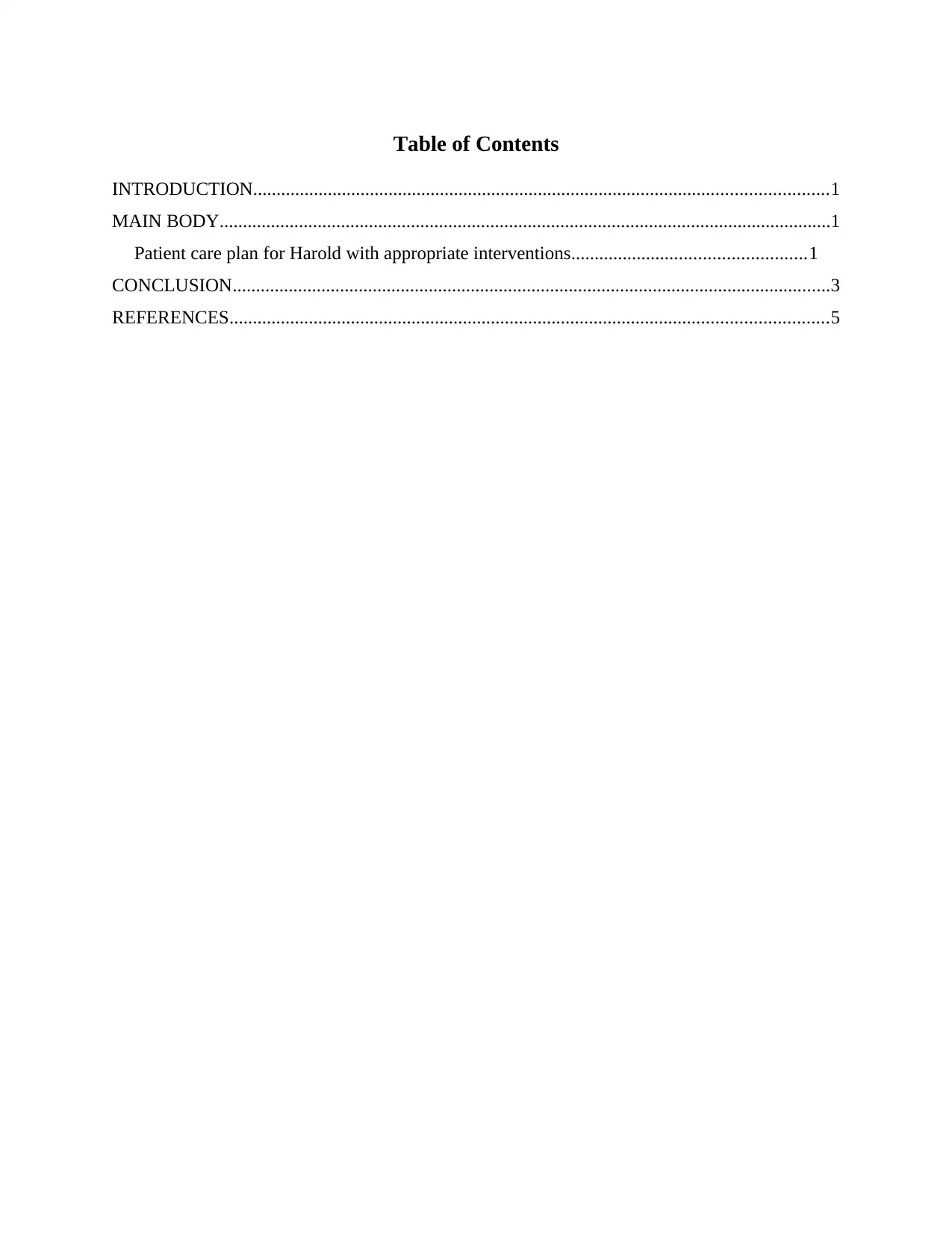
Table of Contents
INTRODUCTION...........................................................................................................................1
MAIN BODY...................................................................................................................................1
Patient care plan for Harold with appropriate interventions..................................................1
CONCLUSION................................................................................................................................3
REFERENCES................................................................................................................................5
INTRODUCTION...........................................................................................................................1
MAIN BODY...................................................................................................................................1
Patient care plan for Harold with appropriate interventions..................................................1
CONCLUSION................................................................................................................................3
REFERENCES................................................................................................................................5
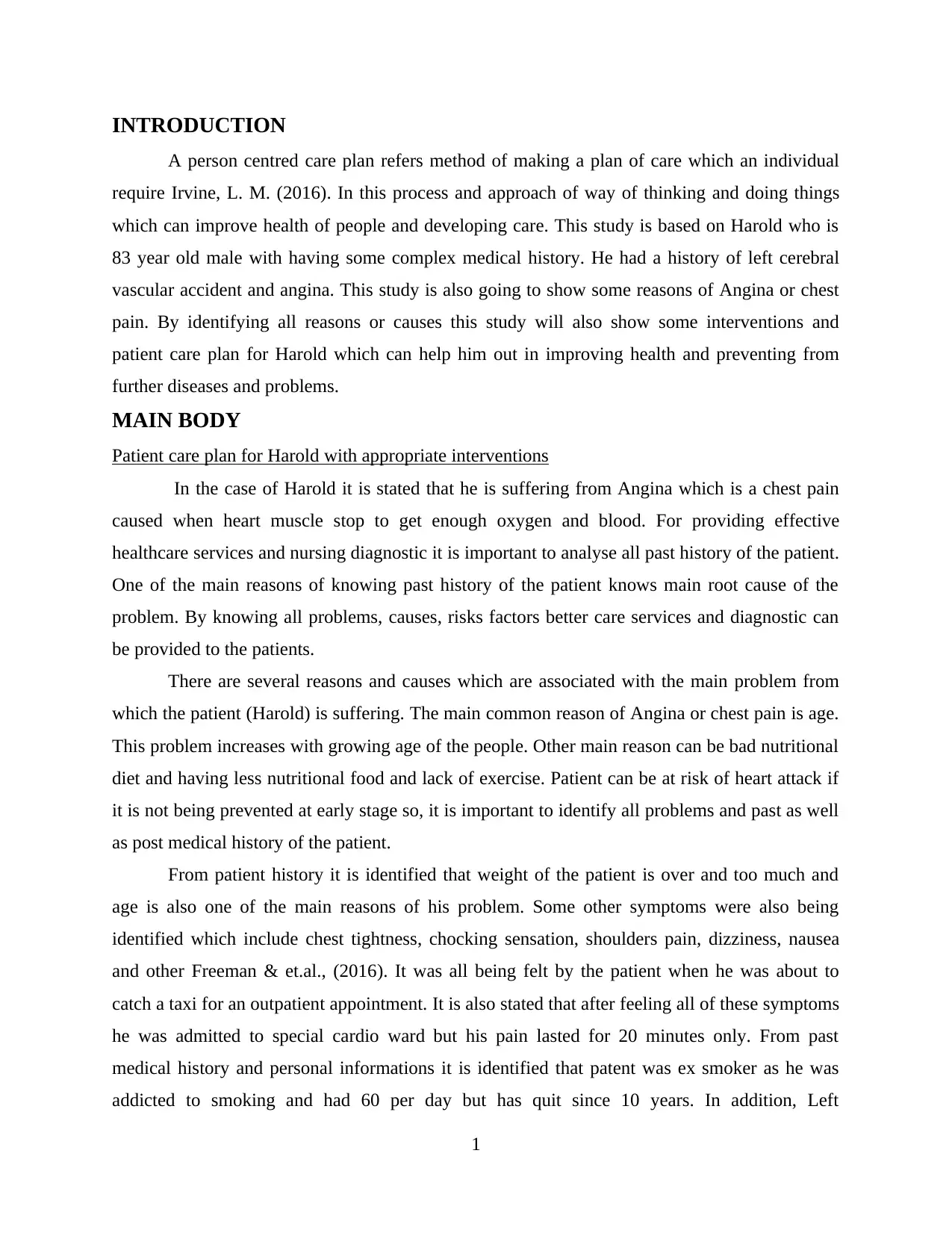
INTRODUCTION
A person centred care plan refers method of making a plan of care which an individual
require Irvine, L. M. (2016). In this process and approach of way of thinking and doing things
which can improve health of people and developing care. This study is based on Harold who is
83 year old male with having some complex medical history. He had a history of left cerebral
vascular accident and angina. This study is also going to show some reasons of Angina or chest
pain. By identifying all reasons or causes this study will also show some interventions and
patient care plan for Harold which can help him out in improving health and preventing from
further diseases and problems.
MAIN BODY
Patient care plan for Harold with appropriate interventions
In the case of Harold it is stated that he is suffering from Angina which is a chest pain
caused when heart muscle stop to get enough oxygen and blood. For providing effective
healthcare services and nursing diagnostic it is important to analyse all past history of the patient.
One of the main reasons of knowing past history of the patient knows main root cause of the
problem. By knowing all problems, causes, risks factors better care services and diagnostic can
be provided to the patients.
There are several reasons and causes which are associated with the main problem from
which the patient (Harold) is suffering. The main common reason of Angina or chest pain is age.
This problem increases with growing age of the people. Other main reason can be bad nutritional
diet and having less nutritional food and lack of exercise. Patient can be at risk of heart attack if
it is not being prevented at early stage so, it is important to identify all problems and past as well
as post medical history of the patient.
From patient history it is identified that weight of the patient is over and too much and
age is also one of the main reasons of his problem. Some other symptoms were also being
identified which include chest tightness, chocking sensation, shoulders pain, dizziness, nausea
and other Freeman & et.al., (2016). It was all being felt by the patient when he was about to
catch a taxi for an outpatient appointment. It is also stated that after feeling all of these symptoms
he was admitted to special cardio ward but his pain lasted for 20 minutes only. From past
medical history and personal informations it is identified that patent was ex smoker as he was
addicted to smoking and had 60 per day but has quit since 10 years. In addition, Left
1
A person centred care plan refers method of making a plan of care which an individual
require Irvine, L. M. (2016). In this process and approach of way of thinking and doing things
which can improve health of people and developing care. This study is based on Harold who is
83 year old male with having some complex medical history. He had a history of left cerebral
vascular accident and angina. This study is also going to show some reasons of Angina or chest
pain. By identifying all reasons or causes this study will also show some interventions and
patient care plan for Harold which can help him out in improving health and preventing from
further diseases and problems.
MAIN BODY
Patient care plan for Harold with appropriate interventions
In the case of Harold it is stated that he is suffering from Angina which is a chest pain
caused when heart muscle stop to get enough oxygen and blood. For providing effective
healthcare services and nursing diagnostic it is important to analyse all past history of the patient.
One of the main reasons of knowing past history of the patient knows main root cause of the
problem. By knowing all problems, causes, risks factors better care services and diagnostic can
be provided to the patients.
There are several reasons and causes which are associated with the main problem from
which the patient (Harold) is suffering. The main common reason of Angina or chest pain is age.
This problem increases with growing age of the people. Other main reason can be bad nutritional
diet and having less nutritional food and lack of exercise. Patient can be at risk of heart attack if
it is not being prevented at early stage so, it is important to identify all problems and past as well
as post medical history of the patient.
From patient history it is identified that weight of the patient is over and too much and
age is also one of the main reasons of his problem. Some other symptoms were also being
identified which include chest tightness, chocking sensation, shoulders pain, dizziness, nausea
and other Freeman & et.al., (2016). It was all being felt by the patient when he was about to
catch a taxi for an outpatient appointment. It is also stated that after feeling all of these symptoms
he was admitted to special cardio ward but his pain lasted for 20 minutes only. From past
medical history and personal informations it is identified that patent was ex smoker as he was
addicted to smoking and had 60 per day but has quit since 10 years. In addition, Left
1
⊘ This is a preview!⊘
Do you want full access?
Subscribe today to unlock all pages.

Trusted by 1+ million students worldwide
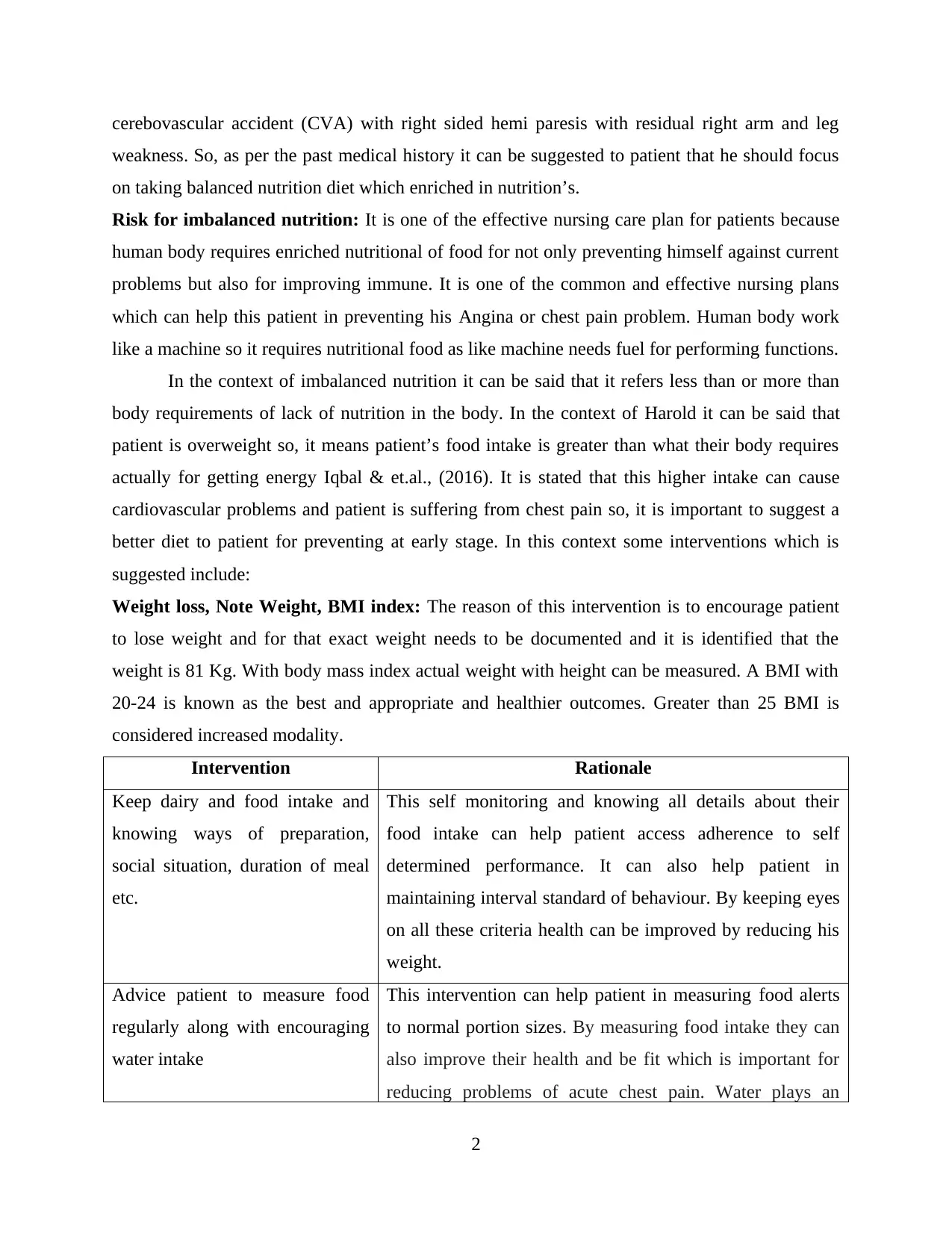
cerebovascular accident (CVA) with right sided hemi paresis with residual right arm and leg
weakness. So, as per the past medical history it can be suggested to patient that he should focus
on taking balanced nutrition diet which enriched in nutrition’s.
Risk for imbalanced nutrition: It is one of the effective nursing care plan for patients because
human body requires enriched nutritional of food for not only preventing himself against current
problems but also for improving immune. It is one of the common and effective nursing plans
which can help this patient in preventing his Angina or chest pain problem. Human body work
like a machine so it requires nutritional food as like machine needs fuel for performing functions.
In the context of imbalanced nutrition it can be said that it refers less than or more than
body requirements of lack of nutrition in the body. In the context of Harold it can be said that
patient is overweight so, it means patient’s food intake is greater than what their body requires
actually for getting energy Iqbal & et.al., (2016). It is stated that this higher intake can cause
cardiovascular problems and patient is suffering from chest pain so, it is important to suggest a
better diet to patient for preventing at early stage. In this context some interventions which is
suggested include:
Weight loss, Note Weight, BMI index: The reason of this intervention is to encourage patient
to lose weight and for that exact weight needs to be documented and it is identified that the
weight is 81 Kg. With body mass index actual weight with height can be measured. A BMI with
20-24 is known as the best and appropriate and healthier outcomes. Greater than 25 BMI is
considered increased modality.
Intervention Rationale
Keep dairy and food intake and
knowing ways of preparation,
social situation, duration of meal
etc.
This self monitoring and knowing all details about their
food intake can help patient access adherence to self
determined performance. It can also help patient in
maintaining interval standard of behaviour. By keeping eyes
on all these criteria health can be improved by reducing his
weight.
Advice patient to measure food
regularly along with encouraging
water intake
This intervention can help patient in measuring food alerts
to normal portion sizes. By measuring food intake they can
also improve their health and be fit which is important for
reducing problems of acute chest pain. Water plays an
2
weakness. So, as per the past medical history it can be suggested to patient that he should focus
on taking balanced nutrition diet which enriched in nutrition’s.
Risk for imbalanced nutrition: It is one of the effective nursing care plan for patients because
human body requires enriched nutritional of food for not only preventing himself against current
problems but also for improving immune. It is one of the common and effective nursing plans
which can help this patient in preventing his Angina or chest pain problem. Human body work
like a machine so it requires nutritional food as like machine needs fuel for performing functions.
In the context of imbalanced nutrition it can be said that it refers less than or more than
body requirements of lack of nutrition in the body. In the context of Harold it can be said that
patient is overweight so, it means patient’s food intake is greater than what their body requires
actually for getting energy Iqbal & et.al., (2016). It is stated that this higher intake can cause
cardiovascular problems and patient is suffering from chest pain so, it is important to suggest a
better diet to patient for preventing at early stage. In this context some interventions which is
suggested include:
Weight loss, Note Weight, BMI index: The reason of this intervention is to encourage patient
to lose weight and for that exact weight needs to be documented and it is identified that the
weight is 81 Kg. With body mass index actual weight with height can be measured. A BMI with
20-24 is known as the best and appropriate and healthier outcomes. Greater than 25 BMI is
considered increased modality.
Intervention Rationale
Keep dairy and food intake and
knowing ways of preparation,
social situation, duration of meal
etc.
This self monitoring and knowing all details about their
food intake can help patient access adherence to self
determined performance. It can also help patient in
maintaining interval standard of behaviour. By keeping eyes
on all these criteria health can be improved by reducing his
weight.
Advice patient to measure food
regularly along with encouraging
water intake
This intervention can help patient in measuring food alerts
to normal portion sizes. By measuring food intake they can
also improve their health and be fit which is important for
reducing problems of acute chest pain. Water plays an
2
Paraphrase This Document
Need a fresh take? Get an instant paraphrase of this document with our AI Paraphraser
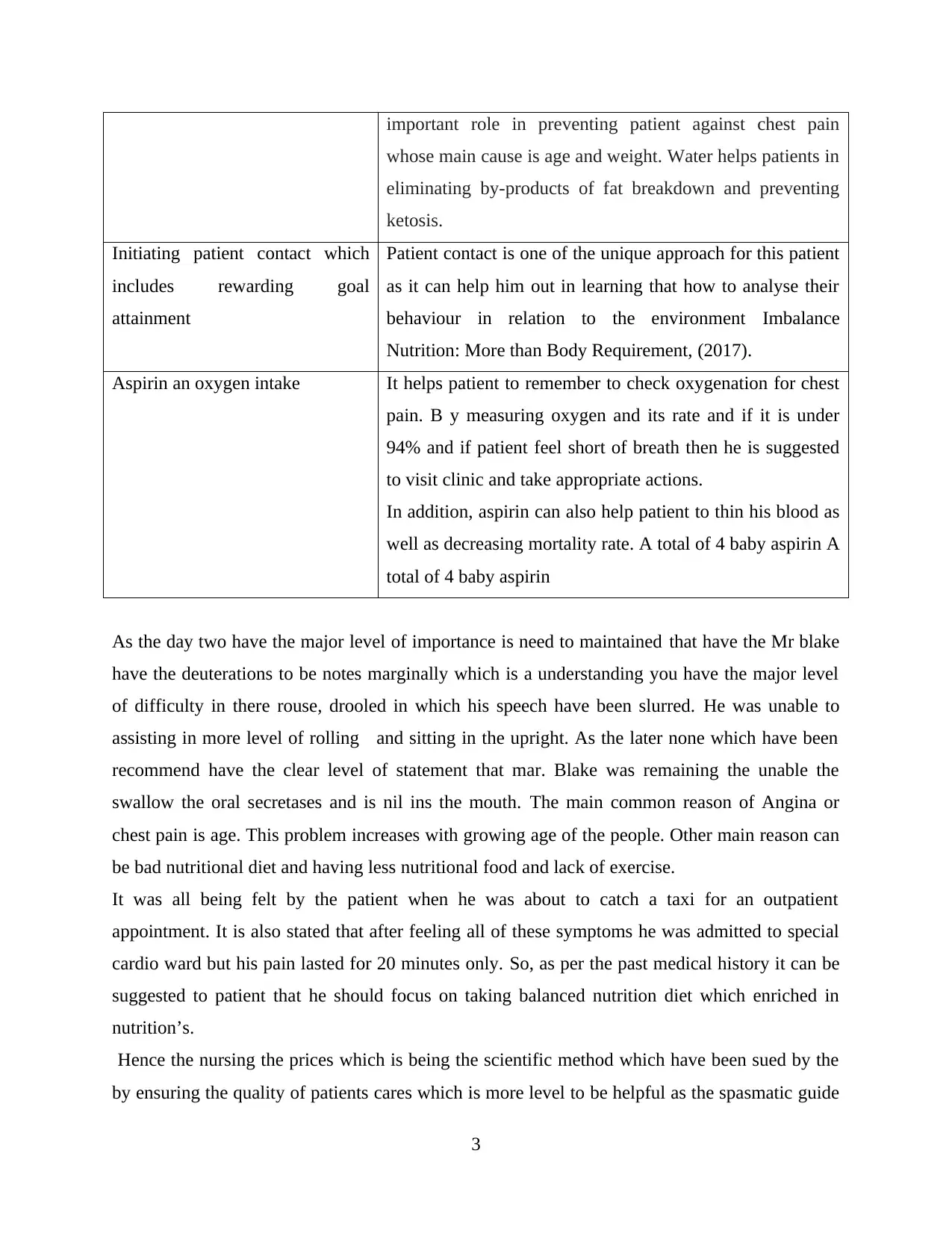
important role in preventing patient against chest pain
whose main cause is age and weight. Water helps patients in
eliminating by-products of fat breakdown and preventing
ketosis.
Initiating patient contact which
includes rewarding goal
attainment
Patient contact is one of the unique approach for this patient
as it can help him out in learning that how to analyse their
behaviour in relation to the environment Imbalance
Nutrition: More than Body Requirement, (2017).
Aspirin an oxygen intake It helps patient to remember to check oxygenation for chest
pain. B y measuring oxygen and its rate and if it is under
94% and if patient feel short of breath then he is suggested
to visit clinic and take appropriate actions.
In addition, aspirin can also help patient to thin his blood as
well as decreasing mortality rate. A total of 4 baby aspirin A
total of 4 baby aspirin
As the day two have the major level of importance is need to maintained that have the Mr blake
have the deuterations to be notes marginally which is a understanding you have the major level
of difficulty in there rouse, drooled in which his speech have been slurred. He was unable to
assisting in more level of rolling and sitting in the upright. As the later none which have been
recommend have the clear level of statement that mar. Blake was remaining the unable the
swallow the oral secretases and is nil ins the mouth. The main common reason of Angina or
chest pain is age. This problem increases with growing age of the people. Other main reason can
be bad nutritional diet and having less nutritional food and lack of exercise.
It was all being felt by the patient when he was about to catch a taxi for an outpatient
appointment. It is also stated that after feeling all of these symptoms he was admitted to special
cardio ward but his pain lasted for 20 minutes only. So, as per the past medical history it can be
suggested to patient that he should focus on taking balanced nutrition diet which enriched in
nutrition’s.
Hence the nursing the prices which is being the scientific method which have been sued by the
by ensuring the quality of patients cares which is more level to be helpful as the spasmatic guide
3
whose main cause is age and weight. Water helps patients in
eliminating by-products of fat breakdown and preventing
ketosis.
Initiating patient contact which
includes rewarding goal
attainment
Patient contact is one of the unique approach for this patient
as it can help him out in learning that how to analyse their
behaviour in relation to the environment Imbalance
Nutrition: More than Body Requirement, (2017).
Aspirin an oxygen intake It helps patient to remember to check oxygenation for chest
pain. B y measuring oxygen and its rate and if it is under
94% and if patient feel short of breath then he is suggested
to visit clinic and take appropriate actions.
In addition, aspirin can also help patient to thin his blood as
well as decreasing mortality rate. A total of 4 baby aspirin A
total of 4 baby aspirin
As the day two have the major level of importance is need to maintained that have the Mr blake
have the deuterations to be notes marginally which is a understanding you have the major level
of difficulty in there rouse, drooled in which his speech have been slurred. He was unable to
assisting in more level of rolling and sitting in the upright. As the later none which have been
recommend have the clear level of statement that mar. Blake was remaining the unable the
swallow the oral secretases and is nil ins the mouth. The main common reason of Angina or
chest pain is age. This problem increases with growing age of the people. Other main reason can
be bad nutritional diet and having less nutritional food and lack of exercise.
It was all being felt by the patient when he was about to catch a taxi for an outpatient
appointment. It is also stated that after feeling all of these symptoms he was admitted to special
cardio ward but his pain lasted for 20 minutes only. So, as per the past medical history it can be
suggested to patient that he should focus on taking balanced nutrition diet which enriched in
nutrition’s.
Hence the nursing the prices which is being the scientific method which have been sued by the
by ensuring the quality of patients cares which is more level to be helpful as the spasmatic guide
3
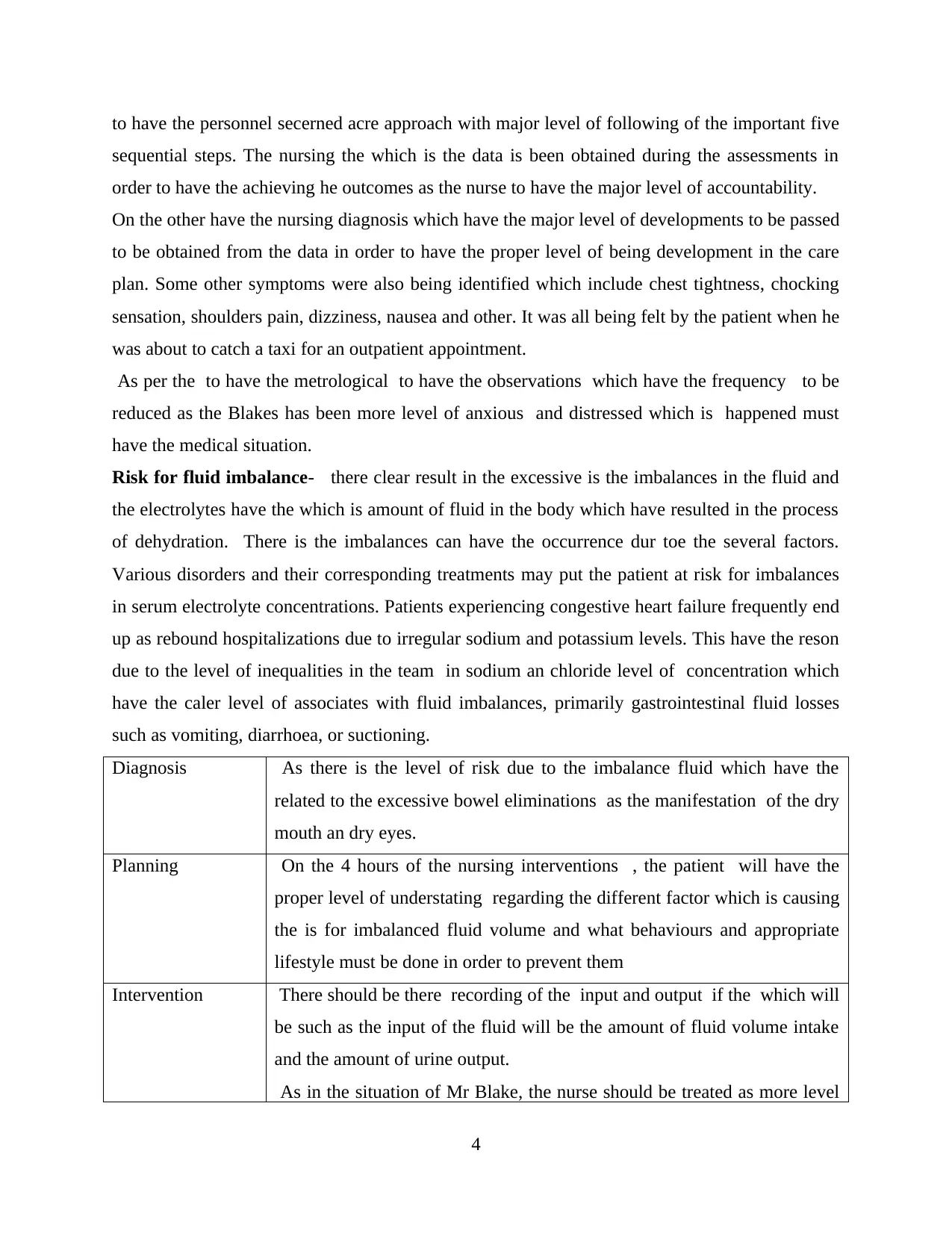
to have the personnel secerned acre approach with major level of following of the important five
sequential steps. The nursing the which is the data is been obtained during the assessments in
order to have the achieving he outcomes as the nurse to have the major level of accountability.
On the other have the nursing diagnosis which have the major level of developments to be passed
to be obtained from the data in order to have the proper level of being development in the care
plan. Some other symptoms were also being identified which include chest tightness, chocking
sensation, shoulders pain, dizziness, nausea and other. It was all being felt by the patient when he
was about to catch a taxi for an outpatient appointment.
As per the to have the metrological to have the observations which have the frequency to be
reduced as the Blakes has been more level of anxious and distressed which is happened must
have the medical situation.
Risk for fluid imbalance- there clear result in the excessive is the imbalances in the fluid and
the electrolytes have the which is amount of fluid in the body which have resulted in the process
of dehydration. There is the imbalances can have the occurrence dur toe the several factors.
Various disorders and their corresponding treatments may put the patient at risk for imbalances
in serum electrolyte concentrations. Patients experiencing congestive heart failure frequently end
up as rebound hospitalizations due to irregular sodium and potassium levels. This have the reson
due to the level of inequalities in the team in sodium an chloride level of concentration which
have the caler level of associates with fluid imbalances, primarily gastrointestinal fluid losses
such as vomiting, diarrhoea, or suctioning.
Diagnosis As there is the level of risk due to the imbalance fluid which have the
related to the excessive bowel eliminations as the manifestation of the dry
mouth an dry eyes.
Planning On the 4 hours of the nursing interventions , the patient will have the
proper level of understating regarding the different factor which is causing
the is for imbalanced fluid volume and what behaviours and appropriate
lifestyle must be done in order to prevent them
Intervention There should be there recording of the input and output if the which will
be such as the input of the fluid will be the amount of fluid volume intake
and the amount of urine output.
As in the situation of Mr Blake, the nurse should be treated as more level
4
sequential steps. The nursing the which is the data is been obtained during the assessments in
order to have the achieving he outcomes as the nurse to have the major level of accountability.
On the other have the nursing diagnosis which have the major level of developments to be passed
to be obtained from the data in order to have the proper level of being development in the care
plan. Some other symptoms were also being identified which include chest tightness, chocking
sensation, shoulders pain, dizziness, nausea and other. It was all being felt by the patient when he
was about to catch a taxi for an outpatient appointment.
As per the to have the metrological to have the observations which have the frequency to be
reduced as the Blakes has been more level of anxious and distressed which is happened must
have the medical situation.
Risk for fluid imbalance- there clear result in the excessive is the imbalances in the fluid and
the electrolytes have the which is amount of fluid in the body which have resulted in the process
of dehydration. There is the imbalances can have the occurrence dur toe the several factors.
Various disorders and their corresponding treatments may put the patient at risk for imbalances
in serum electrolyte concentrations. Patients experiencing congestive heart failure frequently end
up as rebound hospitalizations due to irregular sodium and potassium levels. This have the reson
due to the level of inequalities in the team in sodium an chloride level of concentration which
have the caler level of associates with fluid imbalances, primarily gastrointestinal fluid losses
such as vomiting, diarrhoea, or suctioning.
Diagnosis As there is the level of risk due to the imbalance fluid which have the
related to the excessive bowel eliminations as the manifestation of the dry
mouth an dry eyes.
Planning On the 4 hours of the nursing interventions , the patient will have the
proper level of understating regarding the different factor which is causing
the is for imbalanced fluid volume and what behaviours and appropriate
lifestyle must be done in order to prevent them
Intervention There should be there recording of the input and output if the which will
be such as the input of the fluid will be the amount of fluid volume intake
and the amount of urine output.
As in the situation of Mr Blake, the nurse should be treated as more level
4
⊘ This is a preview!⊘
Do you want full access?
Subscribe today to unlock all pages.

Trusted by 1+ million students worldwide
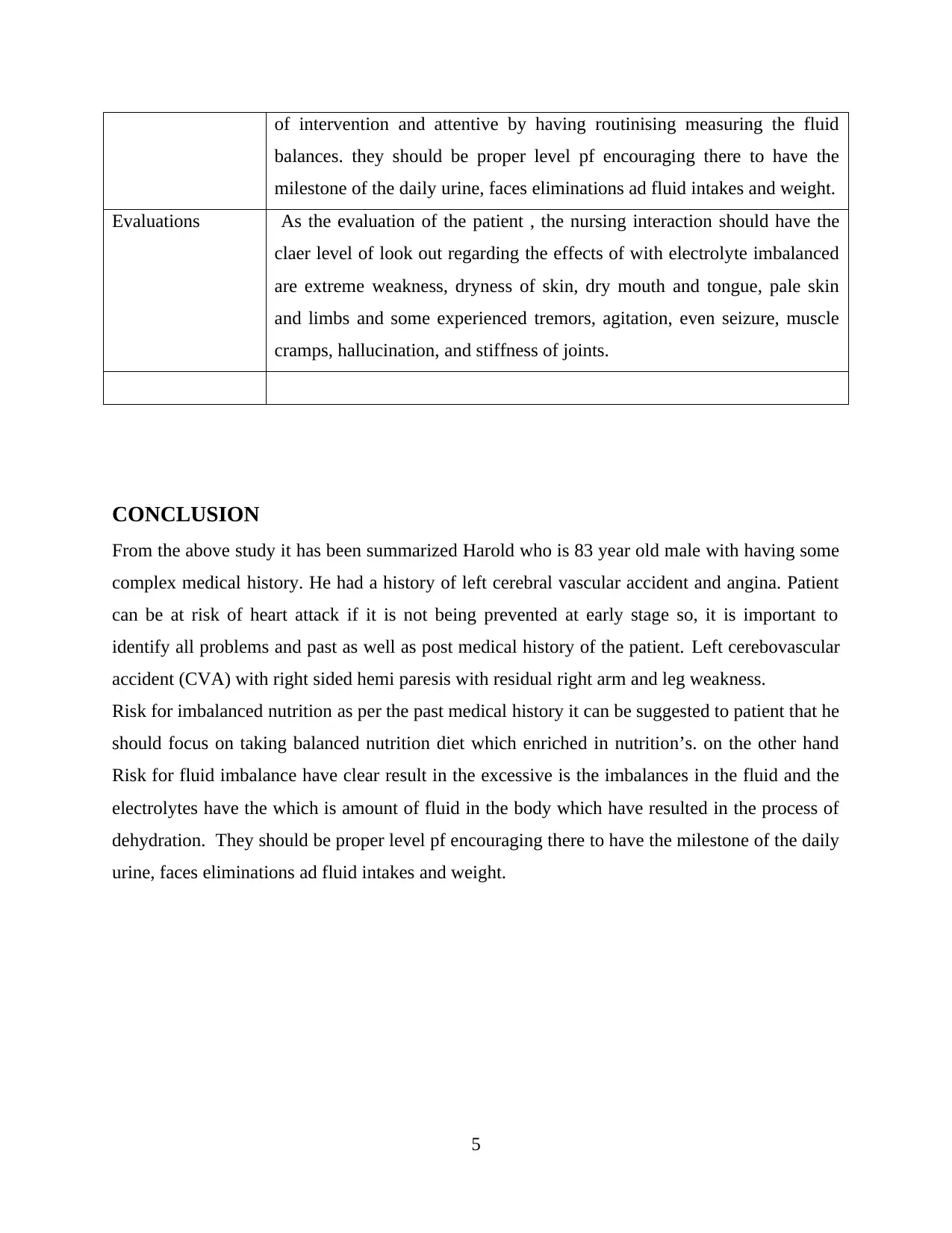
of intervention and attentive by having routinising measuring the fluid
balances. they should be proper level pf encouraging there to have the
milestone of the daily urine, faces eliminations ad fluid intakes and weight.
Evaluations As the evaluation of the patient , the nursing interaction should have the
claer level of look out regarding the effects of with electrolyte imbalanced
are extreme weakness, dryness of skin, dry mouth and tongue, pale skin
and limbs and some experienced tremors, agitation, even seizure, muscle
cramps, hallucination, and stiffness of joints.
CONCLUSION
From the above study it has been summarized Harold who is 83 year old male with having some
complex medical history. He had a history of left cerebral vascular accident and angina. Patient
can be at risk of heart attack if it is not being prevented at early stage so, it is important to
identify all problems and past as well as post medical history of the patient. Left cerebovascular
accident (CVA) with right sided hemi paresis with residual right arm and leg weakness.
Risk for imbalanced nutrition as per the past medical history it can be suggested to patient that he
should focus on taking balanced nutrition diet which enriched in nutrition’s. on the other hand
Risk for fluid imbalance have clear result in the excessive is the imbalances in the fluid and the
electrolytes have the which is amount of fluid in the body which have resulted in the process of
dehydration. They should be proper level pf encouraging there to have the milestone of the daily
urine, faces eliminations ad fluid intakes and weight.
5
balances. they should be proper level pf encouraging there to have the
milestone of the daily urine, faces eliminations ad fluid intakes and weight.
Evaluations As the evaluation of the patient , the nursing interaction should have the
claer level of look out regarding the effects of with electrolyte imbalanced
are extreme weakness, dryness of skin, dry mouth and tongue, pale skin
and limbs and some experienced tremors, agitation, even seizure, muscle
cramps, hallucination, and stiffness of joints.
CONCLUSION
From the above study it has been summarized Harold who is 83 year old male with having some
complex medical history. He had a history of left cerebral vascular accident and angina. Patient
can be at risk of heart attack if it is not being prevented at early stage so, it is important to
identify all problems and past as well as post medical history of the patient. Left cerebovascular
accident (CVA) with right sided hemi paresis with residual right arm and leg weakness.
Risk for imbalanced nutrition as per the past medical history it can be suggested to patient that he
should focus on taking balanced nutrition diet which enriched in nutrition’s. on the other hand
Risk for fluid imbalance have clear result in the excessive is the imbalances in the fluid and the
electrolytes have the which is amount of fluid in the body which have resulted in the process of
dehydration. They should be proper level pf encouraging there to have the milestone of the daily
urine, faces eliminations ad fluid intakes and weight.
5
Paraphrase This Document
Need a fresh take? Get an instant paraphrase of this document with our AI Paraphraser

6
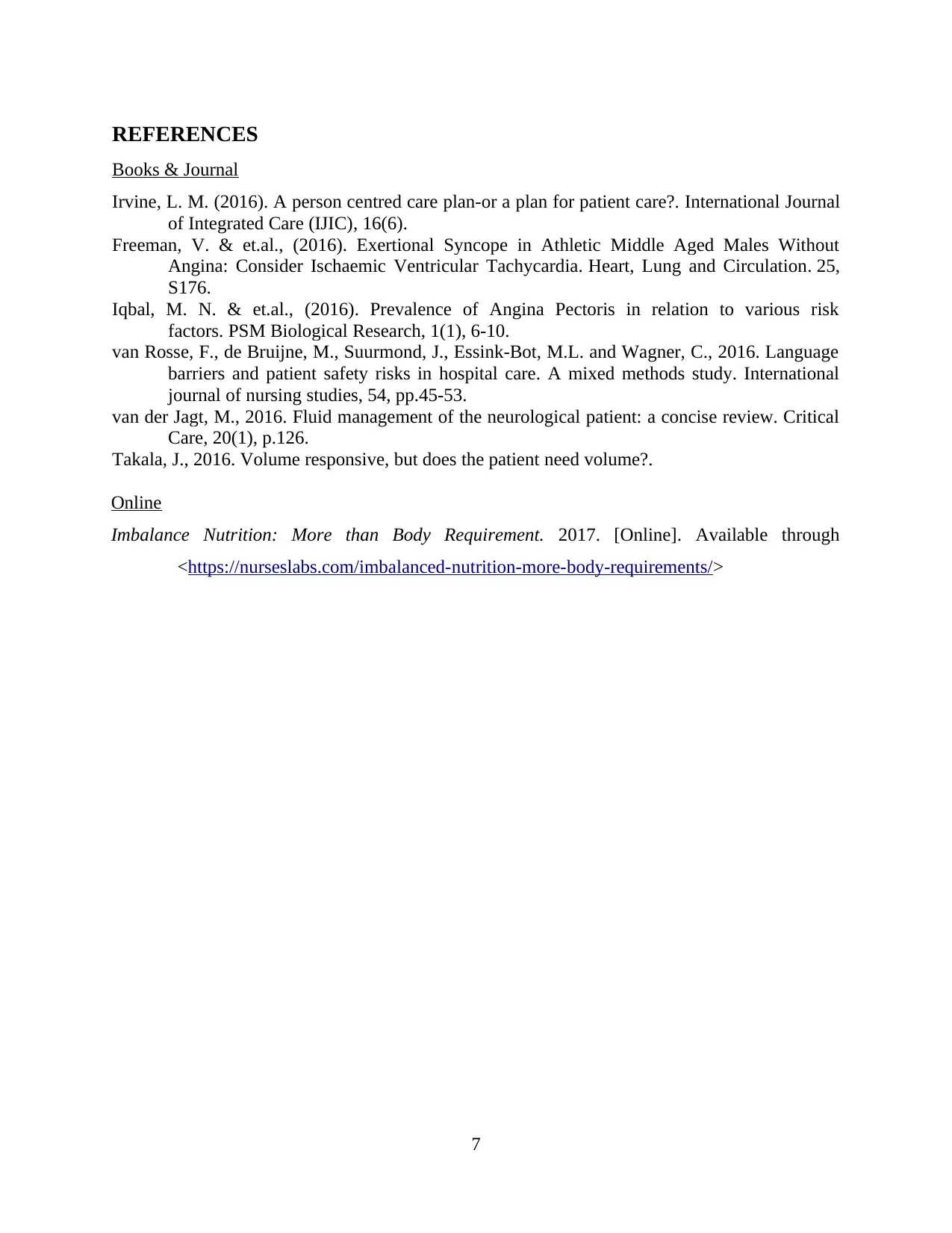
REFERENCES
Books & Journal
Irvine, L. M. (2016). A person centred care plan-or a plan for patient care?. International Journal
of Integrated Care (IJIC), 16(6).
Freeman, V. & et.al., (2016). Exertional Syncope in Athletic Middle Aged Males Without
Angina: Consider Ischaemic Ventricular Tachycardia. Heart, Lung and Circulation. 25,
S176.
Iqbal, M. N. & et.al., (2016). Prevalence of Angina Pectoris in relation to various risk
factors. PSM Biological Research, 1(1), 6-10.
van Rosse, F., de Bruijne, M., Suurmond, J., Essink-Bot, M.L. and Wagner, C., 2016. Language
barriers and patient safety risks in hospital care. A mixed methods study. International
journal of nursing studies, 54, pp.45-53.
van der Jagt, M., 2016. Fluid management of the neurological patient: a concise review. Critical
Care, 20(1), p.126.
Takala, J., 2016. Volume responsive, but does the patient need volume?.
Online
Imbalance Nutrition: More than Body Requirement. 2017. [Online]. Available through
<https://nurseslabs.com/imbalanced-nutrition-more-body-requirements/>
7
Books & Journal
Irvine, L. M. (2016). A person centred care plan-or a plan for patient care?. International Journal
of Integrated Care (IJIC), 16(6).
Freeman, V. & et.al., (2016). Exertional Syncope in Athletic Middle Aged Males Without
Angina: Consider Ischaemic Ventricular Tachycardia. Heart, Lung and Circulation. 25,
S176.
Iqbal, M. N. & et.al., (2016). Prevalence of Angina Pectoris in relation to various risk
factors. PSM Biological Research, 1(1), 6-10.
van Rosse, F., de Bruijne, M., Suurmond, J., Essink-Bot, M.L. and Wagner, C., 2016. Language
barriers and patient safety risks in hospital care. A mixed methods study. International
journal of nursing studies, 54, pp.45-53.
van der Jagt, M., 2016. Fluid management of the neurological patient: a concise review. Critical
Care, 20(1), p.126.
Takala, J., 2016. Volume responsive, but does the patient need volume?.
Online
Imbalance Nutrition: More than Body Requirement. 2017. [Online]. Available through
<https://nurseslabs.com/imbalanced-nutrition-more-body-requirements/>
7
⊘ This is a preview!⊘
Do you want full access?
Subscribe today to unlock all pages.

Trusted by 1+ million students worldwide

Paraphrase This Document
Need a fresh take? Get an instant paraphrase of this document with our AI Paraphraser

1
1 out of 11
Related Documents
Your All-in-One AI-Powered Toolkit for Academic Success.
+13062052269
info@desklib.com
Available 24*7 on WhatsApp / Email
![[object Object]](/_next/static/media/star-bottom.7253800d.svg)
Unlock your academic potential
Copyright © 2020–2025 A2Z Services. All Rights Reserved. Developed and managed by ZUCOL.





